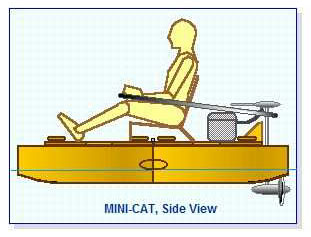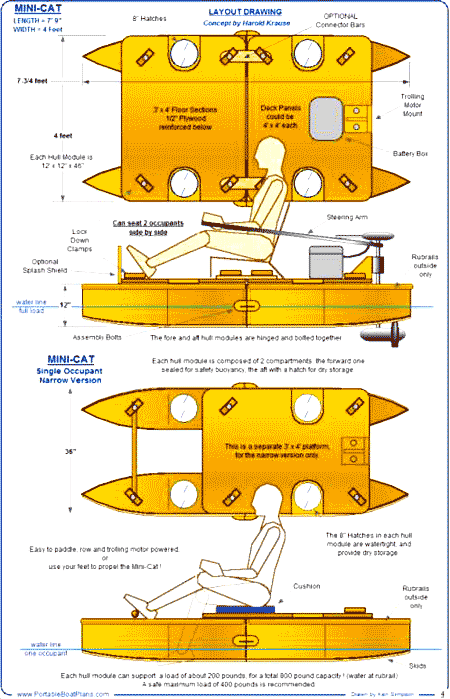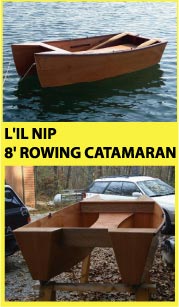
The PortableBoatPlans "2012 Portable Boat Design Contest" is over for another year, and there were two winners (tied
votes). The object of the contest was simple: Develop a concept for a small homemade boat that would appeal to many
other amateur builders. This year the co-winners both provided a design for a catamaran hull platform boat, with some
unique differences. The MINI-CAT by Harold Krause of Texas, featured in this article, is about as basic as you can get, yet
it has the potential to be much more. As drawn, it is a little less than 8 feet long and is 4 feet wide. It easily breaks down
into four hull modules that are each one foot square by 4 feet long. The deck is composed of 2 sections, each 3 feet by 4
feet wide, and only 2 inches thick. Once assembled, the primary means of propulsion is with oars, or paddles, but a trolling
motor is easily adapted to the boat for leisurely cruising, at around 4 MPH.
The second winner is the CAMP CRUISER by James McCabe of Dublin Ireland, a design quite similar in size to the Mini-
Cat, also with a twin-hull, but with an enclosed folding cabin for overnight stays on the water. Because of the extra design
detail required, the plans for this contest winner will take longer to develop.
It's obvious that the voters of the design contest favored the twin-hull designs. Is this a trend?
In the meantime, with the plans of the MINI-CAT complete, construction work should get underway this summer. The
materials list consists of 2 sheets of 5 MM plywood, and 1 sheet of 1/2 inch plywood, in its basic form. Additional materials,
like 1 x 2 lumber and TiteBond 3 waterproof wood glue complete the list. Because of the simplicity of the design, the plans
consist of only 26 pages, including the Tape & Glue Process of joint sealing.

The layout drawing above should provide sufficient information about the configuration and overall capability of this
small, but stable, platform boat. It can support over 400 pounds easily, and will fit in all Trucks, Vans and SUV's for the trip
to and from the water.
As you can see, there are no complicated shapes to this boat, all easy to cut and assemble panels. The plans do outline
in some graphic detail how everything fits together, but leaves open areas for the builder to customize the build to his or
her personal taste. Some of the many options might be fishing rod holders, or a fixed enclosure for a cooler. Also, the
seating is pretty much up to the builders needs, and can even be a folding lawn chair, or two.

Page 1 of the plans give you a sense of what the MINI-CAT is, and what it can do. Because you sit ON, and not IN the
boat, some getting used to will be expected. Perhaps you will want to add a small splash shield to the front of the deck
panel, or a small canopy can be easily constructed to provide shade on those sunny days. The options are only as varied
as your personal wants and needs.

Everything starts at the construction of the 4 hull modules. These are what do the work of holding you steady, and safely,
on the water. Although built of thin, light plywood, each module is strengthened by the use of 1 x 2 edge supports, and all
seams are Taped & Glued for strength, and to prevent water intrusion into the plywood edges. Instructions are intentionally
kept as short as possible, with only detailed descriptions where required. If the builder experiences some
misunderstanding of the plans, the designer is only an e-mail away.

Everyone always wants to know how the whole thing is held together. The above sketch defines the Hull Module Assembly Bolt method of joining the hulls, for a secure yet easy to disassemble process. I have, over the years, tried other methods, but simple Stainless Bolts with fixed T-Nuts has proven to be the easiest to implement.

The article would not be complete without some explanation of the Platform assembly. The 1/2 inch plywood panel is
simply strengthened by the buildup of a cross-laced system of 1 x 2's on edge, with a thin 2 or 3 MM plywood base cover.
The interior is water sealed prior the the placement of the base, so the deck panel also becomes a buoyant platform!
Not big enough ? Simply add a foot or more to each hull module, another deck panel, and make it a family affair.
Obviously, no photos of the finished boat are yet available, but a close study of the plans should give you a sense of what
the MINI-CAT is, and what it can be for you. As mentioned earlier, the basic structure of MINI-CAT can become a great
starting point for a stable twin-hull, portable, safe, and fun platform boat, one that you have always wanted.
Ken
www.PortableBoatPlans.com
Mini-Cat plans are available at Duckworks |











